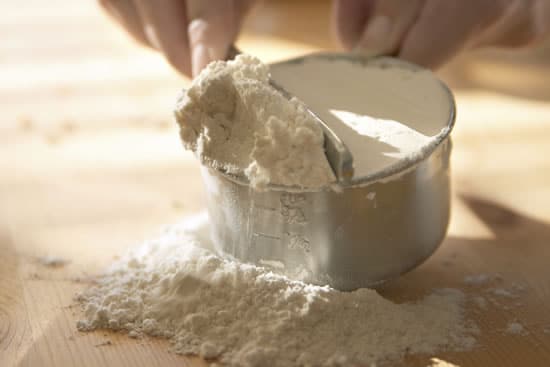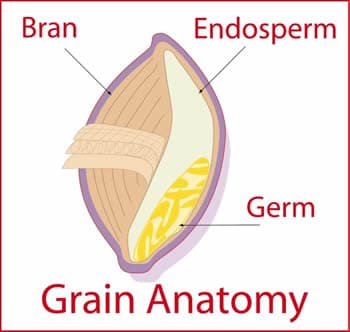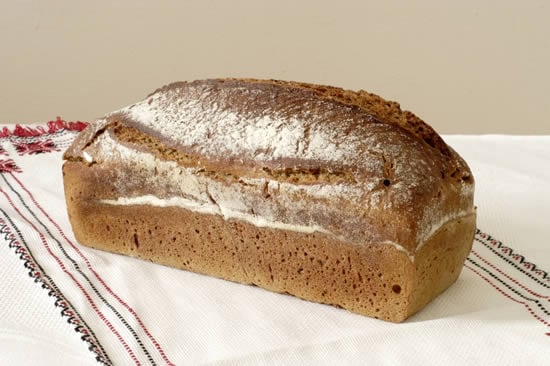The Scoop on White Flour (100% Whole Wheat Bread)
Oct 11, 2011, Updated Oct 03, 2017

White Flour is, at the same time, one of the most coveted ingredients for baking in the world and the nemesis of health-conscious eaters everywhere. White flour is the ever-present ingredient in processed foods and, probably, the single most consumed processed food in the United States (although high fructose corn syrup might give it a run for its money). Andrew asked me to explain how white flour is made, why it might be bleached and enriched, and why whole grains are a far superior choice for your health.
First, a short history lesson
What’s the deal with white flour anyway? How did we end up eating solely nutritionally deplete flour? White flour first appeared in appreciable quantity in the late 1800s with the industrial revolution. Whole wheat flour has a short shelf life; after all, it contains the germ and bran which can cause rancidity. Steam mills came with the age of industry, allowing a lot of flour to be produced quickly and transported all over the country. At the time, “flour” meant whole wheat flour, which will last only about 6 to 9 months before spoiling. To solve this short shelf life problem, millers began sifting out the germ and bran to increase the life for their flour.
In the beginning, white flour was a food of the elite. It was consumed by those with money and those in urban areas. As industry made it cheaper to produce, it became cheaper to buy. Lower income consumers imitated the wealthy and, within a few short years, white flour was the standard for everyone.
Milling
If you know that white flour is made from wheat, you’re one step ahead of a lot of people — truly, I’m not joking. White flour is made by separating the bran and the germ from the endosperm of the grain of wheat. That’s not really as complicated as it sounds — it is simply ground (typically on a high-speed, steel roller mill) and sifted to remove the fluffy white from the heavier brown. The sifting repeats until all that is left is white, fluffy flour. Fine flours, such as cake flour, are sifted more heavily. For a more in-depth description, check out this awesome video from Discovery: How It’s Made Flour.
Bleaching, Bromating, and Enriching
Often you see two types of white flour — unbleached and bleached. Bleaching is done quite simply to make flour that is truly white. Without it, white flour has a slightly off-white color. When white flour was hitting its peak, bleaching was popular to make the whitest cakes and whitest bread possible. While bleaching has become far less popular, it can still be found in many large flour brands and in most processed food.
Potassium Bromate is an enrichment added to help develop the gluten (protein) in baking. It strengthens the dough and encourages rising. Most manufacturers of flour no longer use this enrichment because research has indicated it to be a carcinogen. While it is outright banned in the United Kingdom, the FDA has not banned bromate from use in the United States, though they strongly discourage bakers from using it. Today, most manufacturers of white flour add Malted Barley Flour to bolster their flour. Malted Barley Flour is quite simply barley that has been sprouted, dried and ground into flour.
Other enrichments required by law for conventional white flour include folic acid, niacin, iron, thiamin and riboflavin. These vitamins were originally required by law (circa 1940) to help solve health issues caused by diets deficient in these essential nutrients. These nutrients are naturally found in whole wheat flour and are removed when the germ and bran are removed. Funny, isn’t it? That the government requires us to add enrichment to flour that would have been just fine had it been left whole. With so many Americans relying on white flour, though, it was necessary to help prevent things like neural tube defects in unborn babies.
In the United States, you cannot enrich organic flours — so if you want to skip the added vitamins, go organic. Alternately, in Canada all white flour must be enriched — regardless of its organic status.
Go whole grain, but know before you buy
Many of the giant flour manufacturers in the United States do not grind whole wheat flour from the whole grain. Instead, they separate all three parts of the wheat grain and re-combine them to produce whole wheat flour. It’s far cheaper to produce this way because the majority of their business is in white flour. This is completely legal in the United States and qualifies to be called whole grain. Investigate the source of your whole wheat flour before you buy.
That’s the short version of a very long story about how America became reliant on enriched white flour. For your good health, start switching to whole grain flours such as whole wheat and spelt in your baked goods, choose pasta made with whole wheat flour and pick brown rice over white rice. The nutrients naturally found in whole grains make enrichment unnecessary. Whole grains are packed with fiber and offer variety in flavor and texture. A cookie made with whole wheat pastry flour tastes as good, if not better, than one made with white flour and your conscience can rest easy knowing you fed your family something healthier.

100% Whole Wheat Bread
Ingredients
- 2 Tbsp Active Dry Yeast
- 1/4 cup Warm Water, 110 degrees
- 1/4 cup Honey, + 2 Tbsp
- 1-1/2 tsp Sea Salt
- 3 Tbsp Oil*
- 1-3/4 cups Warm Water, 110 degrees
- 6 cups Stone-Ground Whole Wheat Flour
Instructions
- Dissolve yeast in 1/4 cup warm water. Allow to proof 3-5 minutes.
- Combine next 4 ingredients and add to yeast mixture.
- Stir in flour, mix well. Knead 10 minutes. Let rise 1 hour and 45 minutes.
- Punch down. Let rise 40-60 minutes until doubled.
- Punch down and let rise a third time until doubled.
- Shape into 2 loaves and let rise until doubled.
- Preheat oven to 350 degrees Fahrenheit. Bake for 45 minutes.























Steph,
Yes, definitely. It’s a great flour for a bread machine. No special tips or tricks- just use as you would any other wheat flour.
Can you use this flour in my bread maker? Any particular type of stone ground flour? Anything else I should know about using this flourin my bread maker?
Diane,
It should work ok without the sugar. There should be enough natural sugar in the flour to feed the yeast.
We are on a sugar free diet.
We are not supposed to eat honey, at least not in great quantities.
Can the honey be eliminated from your bread recipe?
Thanks,
Diane
I was wrong in an earlier post when I said this recipe called for three risings, it’s actually four risings when you include the final rise in the pan.
I tried the recipe last night and decided to go with three rises, two in the bowl and the final rise in the bread pan. I’m very disappointed. The bread rose very little in the pan and looks like a brick. I’m sure it will be very dense and still taste good.
How many times do you regulars let this bread rise? Does anybody actually get four rises out of the dough before baking?
Please respond if you make this recipe, thanks.
I just tried this recipe over the weekend and it was so very delicious. It came out fluffy and moist! I used 2tbsp melted butter & 1 tbsp of olive oil and the mixture worked out very well. I prepared one loaf as a cinnamon-currant swirl and it worked like a charm. Thanks for sharing this!
I made this last night and used peanut oil and stone ground wheat from a local farmer in NE ohio. The loaves turned out perfect. They are dense but still light enough for sandwiches. This one is definately going into my list of regulars to make.
Jennifer – where did you get your wheat? I live in NE Ohio as well. Thanks!
I don’t know where I went wrong making this bread but it turned out really badly. I guess I’m kind of new to making bread but not a complete novice. I followed the directions exactly and I’m guessing my errors must have been one or more of the following: Maybe I didn’t let the yeast proof enough (although I did let it sit for 10 minutes), I may have improperly kneaded the bread, my house wasn’t very warm so it may not have been conducive for bread rising, etc. The two loaves turned out pretty hard and flat. HOWEVER, I was bound and determined not to waste the bread SO I waited a few days for it to dry out, dried it a bit more in the oven, and popped it in the food processor. Homemade breadcrumbs 🙂 Next I think I’ll try the Everyday 100% Whole Wheat Bread recipe.
I tried this recipe in my bread machine and the flavor was great but I really think it didn’t rise enough. I expected a dense bread, but not that dense. Maybe I did something wrong. Anyone have tips for using the bread machine for this one? Thanks!
I have not tried this recipe yet because it calls for 3 risings, putting the time into “too long” for right now.
I would suspect that is the problem with using a bread machine. Bread machines have fixed time rising cycles and cannot judge when the loaf has doubled in size. My bread machine has no method of letting it rise a third time, which is called for in this recipe.
That may be why your bread came out so dense.
I have sometimes used mine to do the mixing, and then done the rest in regular loaf pans with the oven.
Try again and comment, please.
Why does it matter if the wheat isseparated, ground and then recombined to be called whole wheat flour as opposed to ground whole?
Also, what can I look for to determine which wheat flour manufacturers use or don’t use the separate and recombine process in making their wheat flour?